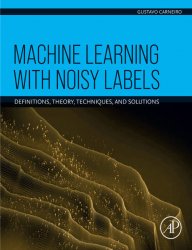Machine Learning with Noisy Labels: Definitions, Theory, Techniques and Solutions
- Добавил: literator
- Дата: 27-06-2024, 01:20
- Комментариев: 0
 Название: Machine Learning with Noisy Labels: Definitions, Theory, Techniques and Solutions
Название: Machine Learning with Noisy Labels: Definitions, Theory, Techniques and SolutionsАвтор: Gustavo Carneiro
Издательство: Academic Press/Elsevier
Год: 2024
Страниц: 312
Язык: английский
Формат: epub
Размер: 43.5 MB
Machine Learning and Noisy Labels: Definitions, Theory, Techniques and Solutions provides an ideal introduction to Machine Learning with noisy labels that is suitable for senior undergraduates, post graduate students, researchers and practitioners using, and researching, Machine Learning methods. Most of the modern Machine Learning models based on Deep Learning techniques depend on carefully curated and cleanly labeled training sets to be reliably trained and deployed. However, the expensive labeling process involved in the acquisition of such training sets limits the number and size of datasets available to build new models, slowing down progress in the field. This book defines the different types of label noise, introduces the theory behind the problem, presents the main techniques that enable the effective use of noisy-label training sets, and explains the most accurate methods.
Shows how to design and reproduce regression, classification and segmentation models using large-scale noisy-label training sets
Gives an understanding of the theory of, and motivation for, noisy-label learning
Shows how to classify noisy-label learning methods into a set of core techniques
Historically, Machine Learning models have been trained with well-curated training sets that contain negligible amount of label noise. Even though these clean-label training sets represent one of the main pillars behind the success of Machine Learning, such careful curation is a process that does not scale to the large datasets that are becoming increasingly available in the field. In fact, as the dataset size increases, the probability of including noisy-label samples also increases due to the considerable costs associated with the careful curation. Moreover, in certain Machine Learning scenarios, such as the interpretation of medical images for disease diagnosis, it is common for expert labelers to exhibit natural disagreements regarding specific labels. The inherent uncertainty caused by expert disagreements in these problems makes them susceptible to a significant amount of label noise that cannot be entirely eliminated, even with an exceedingly careful labeling process. Therefore, the development of new Machine Learning models that can explore extremely large-scale datasets that, perhaps, have not been carefully labeled, or datasets that possess intrinsically uncertain labels, relies on the development of algorithms and models that exhibit robustness to noisy labels.
Such development of noisy-label learning algorithms and models has attracted a fair amount of attention by the research community, leading to the publication of a large number of excellent papers. Consequently, students, researchers, and practitioners who want to be able to read and understand the noisy-label problem would have to navigate through this large amount of papers published in the last 5 to 10 years, which is not an easy task even for experienced professionals. This book has been proposed to facilitate this task, providing students, researchers, and practitioners with a useful source of information in the topic.
The book starts by defining the noisy-label learning problem, then it introduces different types of label noise and the theory behind the problem. It also presents the main techniques and methods that enable the effective use of noisy-label training sets. With this book, the reader will have the tools to be able to understand, reproduce, and design regression, classification, segmentation, and detection models that can be trained with large-scale noisy-label training sets. Advanced Machine Learning courses that cover topics in learning with noisy-label and real-world datasets will greatly benefit from the insights provided in this book.
To summarize, with this book the reader will be able to:
• 1. Successfully design and reproduce regression, classification, detection, and segmentation models using large-scale noisy-label training sets;
• 2. Understand the theory and motivation of noisy-label learning;
• 3. Analyze noisy-label learning methods with respect to a set of core techniques;
• 4. Describe the current state-of-the-art methods and benchmarks available in the field;
• 5. Know how to access the codes and datasets on the internet;
• 6. Know how to discover the best methods for current and future noisy-label problems; and
• 7. Propose innovative noisy-label learning methods.
Скачать Machine Learning with Noisy Labels: Definitions, Theory, Techniques and Solutions
[related-news] [/related-news]
Внимание
Уважаемый посетитель, Вы зашли на сайт как незарегистрированный пользователь.
Мы рекомендуем Вам зарегистрироваться либо войти на сайт под своим именем.
Уважаемый посетитель, Вы зашли на сайт как незарегистрированный пользователь.
Мы рекомендуем Вам зарегистрироваться либо войти на сайт под своим именем.
